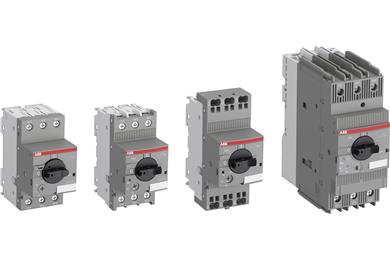A motor starter is an electronically operated switching device that starts or turns on a motor, allowing it to start and stop safely.
The need for a starter is dictated by the type of motor. Generally speaking, low-power motors do not require starters, although what’s considered low power may be debatable. For instance, small dc motors that run on low voltages (24 V or less) don’t require starters. Sometimes it’s said that low-horsepower motors, below 5 hp, don’t require starters either.
The main determining factor involves the amount of current drawn on startup. From Ohm’s law we know that the current is equal to the applied voltage divided by resistance. So if the supply voltage to the motor is high and the resistance low, the amount of inrush current may be 100s of amps, which can damage the motor, causing it to fail.
Motor starter parts
All motor starters have two parts; a contactor and an overload protector.
A contactor supplies current to the motor for startup. The mechanism for doing so is similar to the action of a relay, where a small current on a coil opens or closes contacts that allow a larger current to flow through a circuit. This is the principle of operation of a relay, where a small current controls a much larger current. This allows for remote starting, keeping workers safe by keeping them away from the motor and any potential failures that could cause serious injury.
An overload protector serves to protect the motor from drawing too much current, which could damage the motor by causing it to overheat. Usually it protects against a prolonged overcurrent situation. Typically there is a current sensing circuit in the overload protection unit that senses the amount of current to the motor. On certain types of overload protection units, electronic ones for example, users can set the maximum current level. Some let designers program for a small amount of overload current to prevent what’s known as nuisance tripping. Other types including thermal protection units call for the insertion of a thermal element rated for the desired maximum current.

One way to classify motor starters is as either manual or magnetic. Manual starters are operated by pressing a button or toggle device, which is mechanically linked to the contactor which then opens or closes and either powering up or down the motor. Manual starters are usually found on lower voltage loads. On the other hand, magnetic motor starters offer the benefit of remote starting and automatic operation.
Selecting a motor starter
Selecting the right starter requires knowing the specifics about the application. For example, what type of motor is it (dc, single phase, three phase) and is it a reversing or non-reversing motor? You’ll also need to know the voltage and current ratings of the motor including the supply voltage for the motor as well as any available control voltage (for the starter control circuit). Current ratings include both the full-load current as well as maximum current, which can also be expressed in terms of horsepower rating.
The other consideration is whether to choose a NEMA or IEC rated starter. NEMA starters are generally larger than IEC models, which are typically smaller and more compact. NEMA starters tend to be more expensive than IEC starters, but are also more flexible and can meet requirements in many different applications.

Leave a Reply
You must be logged in to post a comment.